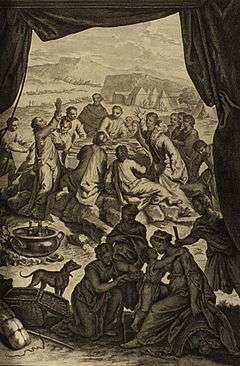Mizpah (emotional bond)

Mizpah (מִצְפָּה) is Hebrew for "watchtower." As mentioned in the Bible story of Jacob and Laban, making a pile of stones marked an agreement between two people, with God as their watching witness.
Jacob had secretly fled the house of Laban, his father-in-law, in the middle of the night, taking flocks of animals, all his other assets, and his two wives and their children (the daughters and grandchildren of Laban) with him, intending never to return. Laban discovered this and pursued Jacob. After discussion, the two decided to formalize the separation.
Laban admitted that his daughters had voluntarily left, saying "(W)hat can I do to these daughters or to the children which they have bore?" (Genesis 31:43). He agreed to let Jacob go in peace, but exacted a promise from Jacob to never abuse his daughters or take additional wives (Genesis 31:50).
The two men then determined to erect a pile of stones, a figurative watchtower, called a mizpah, to commemorate this promise, even though no person was present other than the two men when it was made, for "God is witness between you and me." Both of the men also agreed that they would consider the mizpah a border between their respective territories, and that would not pass the watchtower to visit one another "to do evil" (Genesis 31:52).
Since that time, the mizpah has come to connote an emotional bond between people who are separated (either physically or by death). Mizpah jewelry is often made in the form of a coin-shaped pendant cut in two with a zig-zag line bearing the words "The LORD watch between me and thee, when we are absent one from another" (Genesis 31:49). This is worn to signify the bond. Additionally, the word "mizpah" can often be found on headstones in cemeteries and on other memorials. From Genesis 31:49 of the Bible:
And Mizpah; for he said, The Lord watch between me and thee, when we are absent one from another.
External links